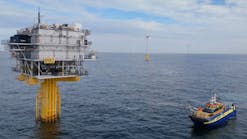VESSELS, RIGS, & SURFACE SYSTEMS
After nearly 40 years, Heerema Marine Contractors (HMC) will retire its semisubmersible crane vessel Hermod at the end of the year. Designed and constructed in the ’70s, the Hermod and her sister vessel Balder were the first semisubmersible crane vessels of its kind in the offshore construction industry. The semisubmersible concept was developed with the aim to extend the operability in the harsh North Sea environment and to deliver superior lifting capacity. This, the company says, allowed it to work faster and during more months of the year than the conventional mono-hull crane vessels of the time.
After delivery by the Japanese Mitsui yard in 1978, theHermod’s first job was the installation of the Piper A platform on the UK continental shelf. She executed her first project outside the North Sea in Brazil in the mid-’80s, followed by projects in the Gulf of Mexico, Southeast Asia, and Africa.
HMC pointed out that throughout her career, theHermod worked in more than 25 countries and was involved in several “first-of” installation projects including:
• Installation of the first North Sea TLP (Hutton) jointly with Balder in 1984
• Installation of the first deepwater foundation piles of the first TLP in the Gulf of Mexico (Auger) in 870 m (2,854 ft) of water in 1992
• Installation of the Tombua Landana compliant tower foundation in Angola in 2008 comprising the world’s largest single piece foundation piles 2.7-m (8.9-ft) diameter, 190-m (623-ft) long and weighing 850 mT each
• Removal of the first large platform in the UK: North West Hutton in 2008/09
• The heaviest lift performed by theHermod was the Peregrino topsides in Brazil in 2010 with a dry weight of 6,287 mT.
TheDockwise Vanguard will transport the vessel from the port of Rotterdam, the Netherlands, to the Zhoushan Changhong International Ship Recycling yard in China for dismantling and recycling. HMC said that the demolition will be performed in a safe and responsible way, in accordance with the Hong Kong International Convention for the Safe and Environmentally Sound Recycling of Ships and in line with the European Union Ship Recycling Regulation.
Transocean scraps six floaters
Transocean Ltd. has reported that it will retire the ultra-deepwater drillshipsGSF Jack Ryan and Deepwater Pathfinder; the ultra-deepwater semisubmersibles Sedco Energy, Sedco Express, and Cajun Express; and the deepwater semisub Transocean Marianas.
The rigs will be classified as held for sale and will be recycled in an environmentally responsible manner. All six rigs were previously cold stacked. The company will recognize an impairment charge of about $1.4 billion during 3Q 2017 associated with these actions.
President and CEO Jeremy Thigpen said: “We continue to enhance the quality of our fleet through the addition of new, high-specification assets, and the retirement of older, less competitive rigs.
“We remain committed to providing our customers with the most technically capable and highest quality ultra-deepwater and harsh environment assets in the industry, and will continue to objectively evaluate our rigs and high-grade our fleet as the market evolves.”
In addition, the drilling contractor recently received an early termination notice from a Chevron subsidiary for the ultra-deepwater drillshipDiscoverer Clear Leader. The drilling contract termination will be effective in November 2017. The original expiration was October 2018. In accordance with the contract terms, Transocean will be compensated through a lump-sum payment of about $148 million in contract termination fees. The payment is expected to be received in 4Q 2017.
Subsea construction vessel ready for Shah Deniz Stage 2 duty
The Baku Shipyard has launched theKhankendi, a new flagship subsea construction vessel for the Shah Deniz Stage 2 project in the Azeri sector of the Caspian Sea.
The Shah Deniz consortium says that the $378-million vessel was specifically designed and built to install the biggest subsea production system for the Shah Deniz Stage 2 project. TheKhankendi will now be deployed to the Shah Deniz field where it is expected to perform subsea installation and construction work over the next 11 years.
The vessel is 155 m (509 ft) in length and 32 m (105 ft) in width with 2,000 sq m (21,528 sq ft) of deck space. It has a total weight of 17,600 metric tons, a carrying capacity of 5,000 metric tons at 6.5 m (21 ft) draft and two engine rooms with 6 x 4.4-MW and 2 x 3.2-MW generators.
It is equipped with dynamic positioning to allow working in 3.5 m (11 ft) significant wave height, a 900-metric ton main crane capable of placing 750-metric ton subsea structures down to 600 m (1,968 ft) below sea level, an 18-man two-bell diving system, two work-class ROVs and a strengthened moonpool.
TheKhankendi is said to be able to carry out complex activities without the need for anchors. The vessel has a maximum capacity of 175 people on board, including the marine crew and discipline specialists. The personnel include both Azerbaijani nationals and expatriates with plans for extensive training, leading to the full nationalization of the staff.








